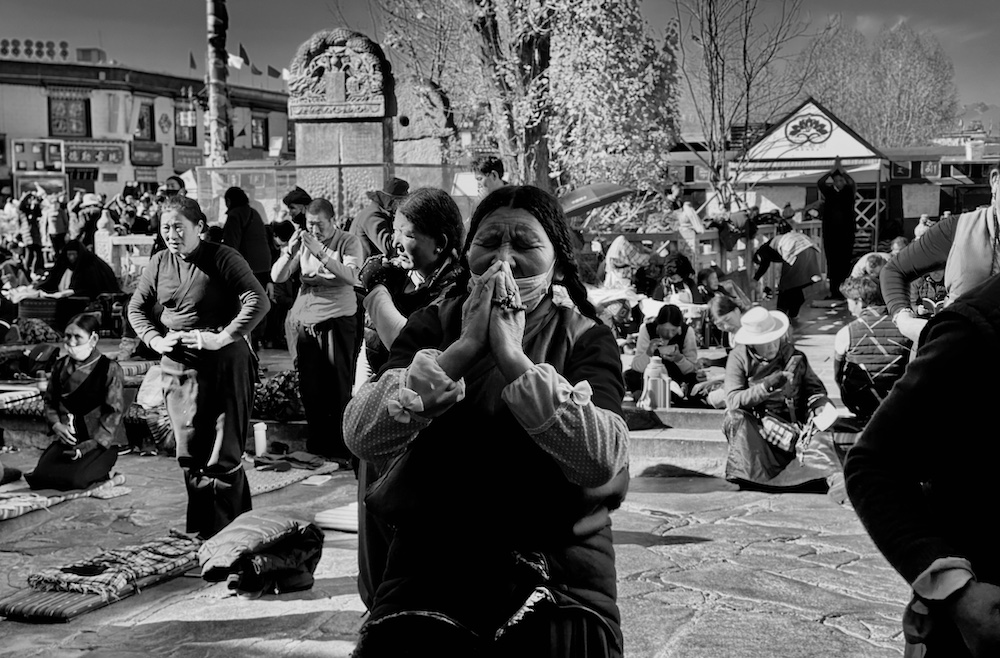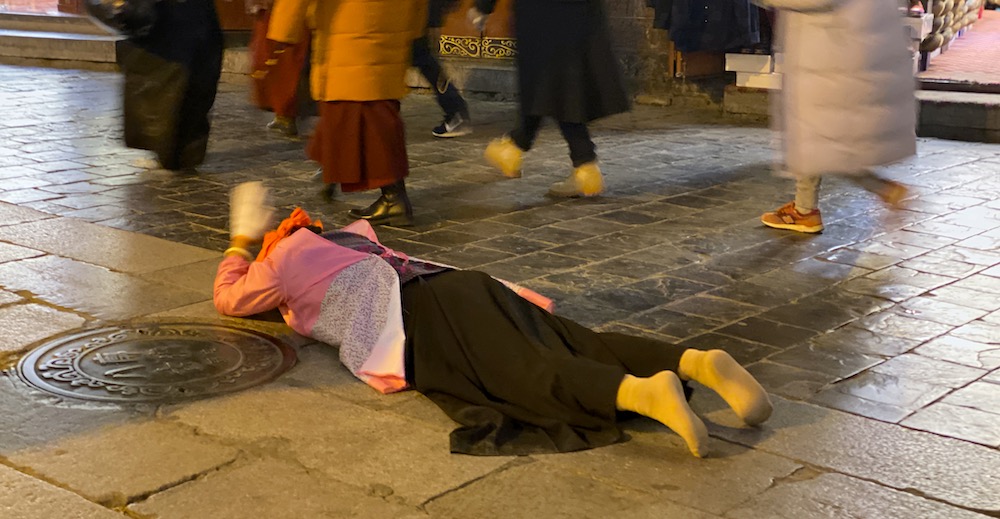Tibet, often called the “Roof of the World,” is a land of profound spiritual significance, where the mountains are revered as sacred, and the air is thick with the resonance of prayer. Among the many spiritual practices that define Tibetan Buddhism, the prostration pilgrimage stands out as one of the most intense and physically demanding expressions of devotion.

This unique form of pilgrimage involves full-body prostrations along pilgrimage routes, sometimes spanning hundreds of kilometers, as a way to accumulate merit, purify karma, and cultivate spiritual humility. In this blog post, we’ll explore the deep spiritual meaning behind the Tibetan prostration pilgrimage, the rigorous journey it entails, and the transformative experience it offers to those who undertake it.
The Spiritual Significance of Prostration in Tibetan Buddhism
Prostration, or chaktsal in Tibetan, is a common practice in Tibetan Buddhism, symbolizing the practitioner’s reverence, humility, and devotion. It involves a series of gestures that begin with standing and culminate in a full-body bow, where the pilgrim lies face down on the ground, arms outstretched, before rising to repeat the motion. This act of lowering oneself to the earth represents the surrender of ego and the acknowledgement of one’s humility before the Buddha, the Dharma (the teachings), and the Sangha (the monastic community).
In Tibetan Buddhism, prostration is not merely a physical act but a spiritual practice that purifies the body, speech, and mind. Each movement is imbued with deep meaning, from placing the hands at the crown of the head (representing the body) to the throat (representing speech) and finally at the heart (representing the mind). The repetition of these movements helps to dissolve the self-centered thoughts and habits that obscure one’s path to enlightenment.
For many Tibetans, prostration is a daily practice, performed in front of shrines, monasteries, and sacred objects. However, the prostration pilgrimage, where practitioners travel great distances using this method, is considered the ultimate act of devotion.
The Prostration Pilgrimage: A Test of Faith and Endurance
The Tibetan prostration pilgrimage is one of the most rigorous spiritual practices in Buddhism. Pilgrims undertake this journey with a deep sense of purpose, often driven by a desire to purify negative karma, seek spiritual blessings, or fulfill a vow. The pilgrimage can be performed along various routes, but it is most commonly associated with the journey to Lhasa, the spiritual heart of Tibet, or to the sacred Mount Kailash, revered by Buddhists, Hindus, Jains, and Bon followers alike.

How the Prostration Pilgrimage is Performed:
1. Preparation: Before embarking on a prostration pilgrimage, practitioners prepare both physically and spiritually. This preparation often includes meditation, prayer, and the accumulation of merit through good deeds and charitable acts. Some pilgrims also seek the guidance of a lama (spiritual teacher) to ensure they are mentally and spiritually ready for the journey.
2. The Prostration Movement: The prostration itself is a sequence of movements that begins with the pilgrim standing upright with hands in a prayer position. The hands are then moved to the crown of the head, throat, and heart, symbolizing the unification of body, speech, and mind with the Three Jewels (Buddha, Dharma, Sangha). The pilgrim then kneels, extends their body forward, and lies flat on the ground with arms outstretched. After a moment of prayer or contemplation, the pilgrim rises and takes three small steps forward before repeating the process.
3. Distance and Duration: The length of a prostration pilgrimage can vary greatly, depending on the route and the pilgrim’s goals. Some may perform prostrations over short distances, such as around a monastery or sacred site, while others embark on epic journeys covering hundreds of kilometers. The pilgrimage to Lhasa from remote regions of Tibet can take months or even years to complete. Pilgrims often perform hundreds of thousands of prostrations over the course of their journey.
4. Support and Sustenance: Given the physical demands of the pilgrimage, many pilgrims travel with basic supplies, such as food, water, and protective clothing. Some are accompanied by family members or friends who provide support, while others travel in groups for mutual encouragement. Pilgrims often wear wooden blocks or pads on their hands to protect them from the rough ground, and they may carry small mats or blankets to lie on.
5. Endurance and Resilience: The prostration pilgrimage is an extraordinary test of physical endurance and mental resilience. Pilgrims face harsh weather conditions, difficult terrain, and the physical toll of repeated prostrations. Yet, for those who undertake this journey, each hardship is embraced as part of the spiritual process, a way to cultivate patience, humility, and unwavering faith.
The Pilgrimage to Lhasa: The Spiritual Heart of Tibet
Lhasa, the capital of Tibet, is the ultimate destination for many prostration pilgrims. The city is home to some of the most sacred sites in Tibetan Buddhism, including the Jokhang Temple and the Potala Palace. Pilgrims from all corners of Tibet and beyond make their way to Lhasa, often traveling for months on foot and performing prostrations along the way.
The Jokhang Temple:
At the heart of Lhasa lies the Jokhang Temple, the holiest site in Tibetan Buddhism. The temple, built in the 7th century by King Songtsen Gampo, houses the Jowo Shakyamuni, a statue of the Buddha that is the most revered object in all of Tibet. For pilgrims, reaching the Jokhang Temple is the culmination of their spiritual journey. Many pilgrims perform the kora (circumambulation) around the temple, prostrating themselves along the Barkhor Circuit, the ancient pilgrimage route that encircles the temple.
The Potala Palace:
Another iconic destination in Lhasa is the Potala Palace, the former winter residence of the Dalai Lama. While the Potala is no longer a religious site in use, it remains a symbol of Tibetan Buddhism and a pilgrimage site of great significance. Pilgrims often circumambulate the palace, offering prayers and prostrations as they go.
The Pilgrimage to Mount Kailash: The Sacred Mountain
Mount Kailash, located in the remote western region of Tibet, is considered the holiest mountain in the world by Buddhists, Hindus, Jains, and Bon followers. It is believed to be the abode of the gods and the center of the universe, making it a powerful destination for pilgrimage.
The Kailash Kora:
The pilgrimage route around Mount Kailash, known as the Kailash Kora, is a 52-kilometer (32-mile) circuit that takes pilgrims through some of the most awe-inspiring and challenging terrain in Tibet. The kora typically takes three days to complete, with pilgrims performing prostrations along the entire route. The journey is not only physically demanding, with altitudes reaching over 5,600 meters (18,400 feet) at the Drolma La Pass, but also deeply spiritual, as each step is believed to bring the pilgrim closer to enlightenment.
Spiritual Rewards:
Completing the Kailash Kora is said to cleanse the soul and absolve sins accumulated over many lifetimes. For many pilgrims, this journey is the pinnacle of their spiritual life, a way to connect with the divine and achieve a deeper understanding of the universe.
The Transformative Power of Prostration Pilgrimage
A prostration pilgrimage in Tibet is more than just a physical journey; it is a profound spiritual practice that transforms the mind, body, and soul. The act of prostration is a powerful symbol of surrender, humility, and devotion, and the pilgrimage itself is a way to confront and transcend the limitations of the self.
Physical Transformation:
The repetitive motion of prostration, combined with the physical challenges of the pilgrimage, leads to a profound transformation of the body. Pilgrims often lose weight, develop greater physical endurance, and gain a deep sense of resilience. The physical hardships are seen as a way to purify the body and prepare it for spiritual insight.
Mental Transformation:
The prostration pilgrimage is also a journey of the mind. The repetitive nature of the prostrations encourages a meditative state, where the mind becomes focused and calm. Pilgrims learn to let go of attachments, fears, and distractions, cultivating a sense of inner peace and clarity.
Spiritual Transformation:
Ultimately, the prostration pilgrimage is a journey of the spirit. Through the act of prostration, pilgrims connect with the divine, offering their entire being in devotion. The pilgrimage is a way to accumulate merit, purify karma, and draw closer to enlightenment. For many, the journey is a turning point in their spiritual life, leading to a deeper understanding of themselves and their place in the universe.
Practical Considerations for Undertaking a Prostration Pilgrimage
If you are considering undertaking a prostration pilgrimage in Tibet, there are several practical considerations to keep in mind:
1. Physical Preparation:
A prostration pilgrimage is physically demanding, requiring a high level of endurance and stamina. Begin a training regimen that includes walking, hiking, and strengthening exercises to prepare your body for the journey.
2. Mental Preparation:
The pilgrimage is as much a mental challenge as it is a physical one. Spend time in meditation and prayer to cultivate the mental focus and resilience needed for the journey.
3. Acclimatization:
Tibet’s high altitude can cause altitude sickness, especially for those unaccustomed to such elevations. Spend several days acclimating in a lower-altitude area before beginning your pilgrimage, and take the journey slowly to allow your body to adjust.
4. Equipment and Supplies:
Pack wisely for the journey, including warm clothing, protective gear for your hands and knees, and basic supplies such as food, water, and a first aid kit. Consider bringing a small mat or blanket for comfort during prostrations.
5. Respect for Local Customs:
Tibet is a deeply spiritual place, and it is important to respect local customs and traditions. Dress modestly, avoid disrupting sacred sites, and be mindful of the spiritual significance of the pilgrimage.
Conclusion
The Tibetan prostration pilgrimage is one of the most profound expressions of faith and devotion in the world. It is a journey that tests the limits of the body and the mind, but it also offers unparalleled spiritual rewards. Whether you are a devout Buddhist or simply seeking a deeper connection with the sacred, a prostration pilgrimage in Tibet provides a path to transformation, enlightenment, and a deeper understanding of the self and the universe. The journey may be long and arduous, but for those who undertake it, the rewards are beyond measure.
